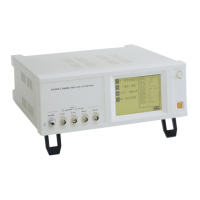146
────────────────────────────────────────────────────
5.7 Supplying DC Bias
────────────────────────────────────────────────────
Z
+
−
3522-50
+
−
Sample to be tested
DC voltage
source
H
POT
H
CUR
L
POT
L
CUR
R or L (>>Z)
GUARD
Capacitor
C
HC
C
HP
DC Bias Voltage Circuit
To supply a DC bias voltage to a capacitor or the like, proceed as follows.
Use the optional 9268 DC BIAS VOLTAGE UNIT (Maximum input current
DC40 V).
For details on using the 9268, refer to the Instruction Manual of the 9268.
(Depending on the test frequency, test signal level, and test range, the 9268
cannot be used.)
Use the 9268 at more 100.1Hz or more with the EXT DC bias of the 3522-
50 switched off.
If the 9268 is not used, refer to the following.
Use a resistance (R) or inductance (L) which has a large enough impedance
with reference to the sample under test (Z).
A Hcur side capacitor must have a small enough impedance (i.e. a large
enough capacitance) relative to the output resistance (50
Ω
) while a Hpot
capacitor must have a small enough impedance to the input resistance (10k
Ω
).
Be careful about the polarity when connecting together the probes, the
sample to be tested, and the DC voltage source.
It takes a little time for the DC voltage which is being supplied to the
sample under test to reach the set voltage, so you should wait for a certain
stabilization time period (which depends upon the sample) before performing
testing. Be careful, because if you perform testing before this stabilization
time period has elapsed, the results will not be reliable.
After testing is completed, drop the voltage of the DC voltage source to
zero, and remove the sample under test from the probes after having
discharged any electric charge which may have built up.
If you have removed the sample under test from the probes without first
having discharged the accumulated electric charge, you should be careful to
do so immediately.

